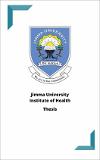IPHC-E Repository System
Dracunculiasis disease prevention behaviors and associated factors among households in Gog district, Gambella Region, Southwestern Ethiopia: Using Health Belief Model, 2014
- Home
- →
- Universities
- →
- Jimma University, Institute of Health
- →
- JU Theses and Dissertations
- →
- View Item
JavaScript is disabled for your browser. Some features of this site may not work without it.
| dc.contributor.author | Alemayehu, Nahusenay | |
| dc.date.accessioned | 2021-05-12T07:20:57Z | |
| dc.date.available | 2021-05-12T07:20:57Z | |
| dc.date.issued | 2014-06-30 | |
| dc.identifier.uri | http://repository.iifphc.org/handle/123456789/1294 | |
| dc.identifier.uri | https://repository.ju.edu.et/handle/123456789/686 | |
| dc.description.abstract | Back ground: Dracunculiasis is a water-borne parasitic infection caused by Dracunculus medinensis and limited to remote, rural villages in Chad, Ethiopia, Mali and South Sudan of that do not have access to safe drinking water. Ethiopia accounts 7 cases from the total Dracunculiasis disease occurrences worldwide in 2013. Objectives: The objective of this study is to assess Dracunculiasis disease prevention behaviors and associated factors among households in Gog District, Gambella Region, Southwestern Ethiopia, 2014. Methods: A community based cross-sectional study is conducted among households who had been living in Gog district, Gambella region. The data was collected by using an interviewer’s administered questionnaire from a total of 442 household head. The data were collected using health belief model items, knowledge and socio demographic questionnaire and entered by using EPI data version 3.1 and analyzed by using statistical package for social science version 16. The reliability of instruments was checked by Cronbach alpha. Data analysis statistical tools, included descriptive statistics, bivariate and multiple logistic regression analysis was conducted to identify factors significantly associated with dracunculiasis preventive behaviors. Result: A total of 429 respondents with a response rate of 97% were participated in the study. 145(33.8%) of households were engaged in dracunculiasis preventive behavior. 267(62.2%) of the respondent were not filtered their drinking water in past two weeks. Socio demographic variables, marital status, religion, educational level, occupational status, income level and from health belief model constructs perceived threat and perceived net benefits were significant predictor of households dracunculiasis preventive behaviors, whereas self-efficacy, cues to action and knowledge was no significant relation with the preventive behaviors. For one score increase in perceived threat of disease and perceived net benefits of preventive behavior, the log odds that the households will have to engage in preventive behavior will increased by 0.056 and 0.036 with (AOR=1.06, 95% CI: 1.03, 1.09) and (AOR=1.04, 95% CI:1.003,1.07) respectively. Conclusion and recommendation: Dracunculiasis disease preventive behavior of the households was very low. Marital status, religion, educational status, work condition, household’s income status, Perceived threat and perceived net benefits have positive effects on Dracunculiasis disease preventive behaviors. Different partners, zonal woreda administrative should avail safe water supply for the community and the eradication program should be design to focus households. | |
| dc.language.iso | English | |
| dc.publisher | Jimma University | |
| dc.subject | Neglected tropical diseases | |
| dc.title | Dracunculiasis disease prevention behaviors and associated factors among households in Gog district, Gambella Region, Southwestern Ethiopia: Using Health Belief Model, 2014 | |
| dc.type | Thesis |
